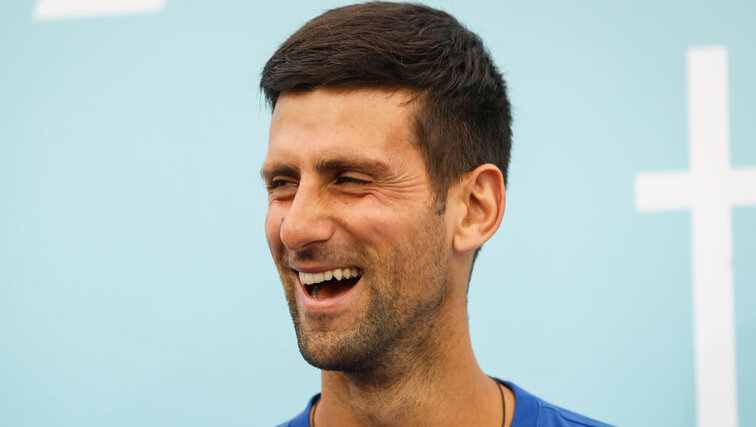Scoring with tactics: Why even the best tennis players lose almost half of all points
In tennis, you don't have to win all the points - just the important ones. And the top players show how it's done! An excerpt from the new tennis book Scoring with Tactics: The Art of Thinking About Tennis .
by Florian Goosmann
last edit:
Sep 22, 2022, 09:55 am

Each of us probably remembers very special tennis games. Of the first media game, maybe also of a pack that you put in your pocket
had to. Or the decisive ascent game. And of course in matches where you might have played your best tennis.
Why the latter? Well, because unfortunately that rarely happens. Be honest: How often did you unpack your best tennis during the past season, in a training match or on the day of the Medenspiel? Twice? 3 times? Congratulations, that's great! Conversely, it means that you haven't played perfectly 30, 40 or 50 times.
If we extrapolate how big the chances are that we will play our best tennis in an important match, we won't get far if we want to increase the winning tally. We have to tackle the days when things don't come together - which is usually the case. The good thing: the opponent feels the same way. If he gets his creamy day against us of all things and wipes us away, we have to congratulate him. However, you will play the lion's share of matches if neither you nor your opponent hit everything. Let's just be aware of that.
The Evil Tennis Count
A second thing: In tennis, wins or losses often sound brutal. A 0: 6, 1: 6 you rarely need to talk yourself over, but many are apparent
straight defeats in absolute numbers are not as clear as they sound.
A little mind game. Let's pit player A against player B. In the first service game it goes like this: 15-0, 30-0, 30-15, 30-30, 40-30, Deuce, Advantage A, Deuce, Advantage A, Deuce, Advantage A, Deuce, Advantage A, Deuce, Advantage A, debut, advantage B, game B – 1:0. A scored 8 points, B scored 10. Let's make the next two games similar, just the same for the sake of simplicity. Then A made a total of 24 points, while B had 30. Tight box, right? Well, it's 3-0 to B. Our poor A might as well not have made a point. Welcome to tennis scoring!
In close matches, it's all about the big points
Even a 6:4, 6:4 often sounds more relaxed than it really was. Let's assume everything went smoothly up to 5:4, then it's 30:30. If player B scores two points, it's still equal (5:5). If A suddenly pulls two forehands onto the line, the set is gone (6:4). Conversely, a 6:0, 6:1 often sounds clearer than the total score did. This often turns in a range of 52:28 (the loser has certainly often reached "15" or "30" or "debut"). Only: The points that he made no longer appear at the end (because he almost never got to the "game").
It's not even particularly uncommon for the winner of a tennis match to score fewer points than the loser. With a 1:6, 7:6, 7:6 it is even likely. Conclusion: Especially in tight games, the big points are important in tennis. With a score of 4:1, 40:0 it doesn't really matter if a forehand flies into the prairie. But not at 6:5, 30:30. This is where the top player differs from the wider circle, at the professional and club level. Good players regularly go a step further here. Above all, they avoid stupid actions.
The top players lose 47 percent of their points!
Craig O'Shannessy, the data guru in pro tennis, unpacked an interesting statistic . How many points do you think number one
to win ten of the tennis world in one season (percentage)? It was only 52.79 percent in 2018! That means: The ten best players of the
World lost 47.21 percent of all points they played! Again in concrete numbers, because it sounds so absurd: The best
ten tennis players in the world have made an average of 53 out of 100 points played - and lost 47!
The best of the year, Novak Djokovic, still won 80 percent of his matches. And John Isner, the world number ten in 2018, at least 59 percent. With "only" 53 percent of points won, that's a strong record that shows how important the crucial points are. And how
distinguish the top players from the rest.
Another crass example. Serving giant and tiebreak lover Ivo Karlovic ended 2016 ranked 20th in the world. He has won 57 percent of his matches this year. The overall point distribution: 4,612 points won and 4,611 points lost. So Karlovic won half his points and lost half, but won 57 percent of his matches. That's how small the margins are in tennis, at least in reasonably tight games.
Insidious tip
You can take advantage of tennis counting by learning to start over mentally. In what was actually a tight match, did you lose the first round 6-1? Switch off! Round two starts again from zero. In the end it doesn't matter whether it was 1:6 or 6:7 beforehand
Total score is the same: you are one set behind.
Important: Start the second sentence with a high level of concentration! Because often the winner of the first sentence relaxes for a moment, he catches his breath briefly. Get the early lead in set two with focus!
#IMG2#
Scoring with tactics: The art of thinking about tennis was recently published. You can order it from Amazon , Thalia , Hugendubel or Copress-Verlag , among others. And of course at your trusted bookstore!
Here you can browse something.
